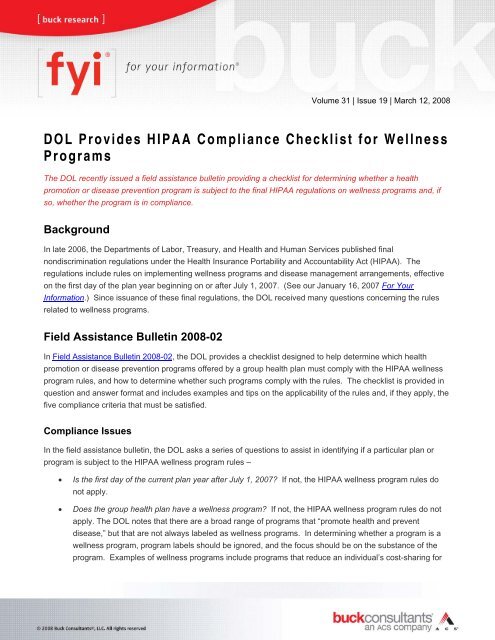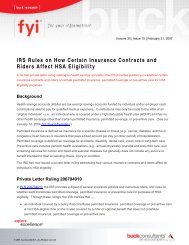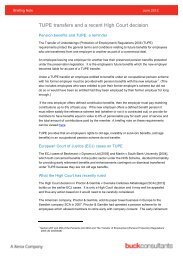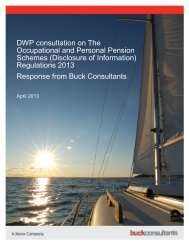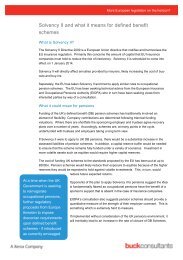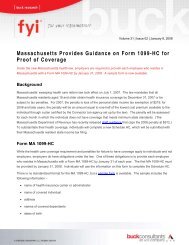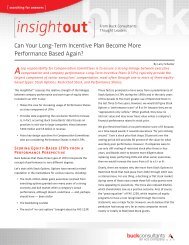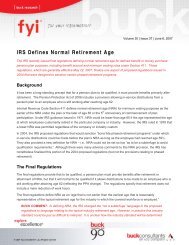DOL Provides HIPAA Compliance Checklist for Wellness Programs
DOL Provides HIPAA Compliance Checklist for Wellness Programs
DOL Provides HIPAA Compliance Checklist for Wellness Programs
Create successful ePaper yourself
Turn your PDF publications into a flip-book with our unique Google optimized e-Paper software.
Volume 31 | Issue 19 | March 12, 2008<br />
<strong>DOL</strong> <strong>Provides</strong> <strong>HIPAA</strong> <strong>Compliance</strong> <strong>Checklist</strong> <strong>for</strong> <strong>Wellness</strong><br />
<strong>Programs</strong><br />
The <strong>DOL</strong> recently issued a field assistance bulletin providing a checklist <strong>for</strong> determining whether a health<br />
promotion or disease prevention program is subject to the final <strong>HIPAA</strong> regulations on wellness programs and, if<br />
so, whether the program is in compliance.<br />
Background<br />
In late 2006, the Departments of Labor, Treasury, and Health and Human Services published final<br />
nondiscrimination regulations under the Health Insurance Portability and Accountability Act (<strong>HIPAA</strong>). The<br />
regulations include rules on implementing wellness programs and disease management arrangements, effective<br />
on the first day of the plan year beginning on or after July 1, 2007. (See our January 16, 2007 For Your<br />
In<strong>for</strong>mation.) Since issuance of these final regulations, the <strong>DOL</strong> received many questions concerning the rules<br />
related to wellness programs.<br />
Field Assistance Bulletin 2008-02<br />
In Field Assistance Bulletin 2008-02, the <strong>DOL</strong> provides a checklist designed to help determine which health<br />
promotion or disease prevention programs offered by a group health plan must comply with the <strong>HIPAA</strong> wellness<br />
program rules, and how to determine whether such programs comply with the rules. The checklist is provided in<br />
question and answer <strong>for</strong>mat and includes examples and tips on the applicability of the rules and, if they apply, the<br />
five compliance criteria that must be satisfied.<br />
<strong>Compliance</strong> Issues<br />
In the field assistance bulletin, the <strong>DOL</strong> asks a series of questions to assist in identifying if a particular plan or<br />
program is subject to the <strong>HIPAA</strong> wellness program rules –<br />
• Is the first day of the current plan year after July 1, 2007 If not, the <strong>HIPAA</strong> wellness program rules do<br />
not apply.<br />
• Does the group health plan have a wellness program If not, the <strong>HIPAA</strong> wellness program rules do not<br />
apply. The <strong>DOL</strong> notes that there are a broad range of programs that “promote health and prevent<br />
disease,” but that are not always labeled as wellness programs. In determining whether a program is a<br />
wellness program, program labels should be ignored, and the focus should be on the substance of the<br />
program. Examples of wellness programs include programs that reduce an individual’s cost-sharing <strong>for</strong>
Volume 31 | Issue 19 | March 12, 2008<br />
complying with a preventative care plan, diagnostic testing programs <strong>for</strong> health problems, and rewards <strong>for</strong><br />
attending educational classes, following healthy lifestyle recommendations, or meeting certain biometric<br />
targets.<br />
• Is the wellness program part of a group health plan If not, the <strong>HIPAA</strong> wellness program rules do not<br />
apply. Although wellness programs that are operated as an employment policy separate from the group<br />
health plan are not subject to the <strong>HIPAA</strong> rules, these programs may still be subject to other provisions of<br />
ERISA or other applicable state or federal law.<br />
BUCK COMMENT. For example, in Rodrigues v. The Scotts Company, LLC, a federal district court judge<br />
refused to dismiss an ERISA claim brought by a newly hired employee who was terminated <strong>for</strong> violating the<br />
company’s nicotine-free policy. The stated purpose of the policy was to save money on health insurance<br />
and promote healthy life styles of employees. The employee claims that the company’s action violated<br />
ERISA Section 510 by preventing him from participating in the company’s benefit plan. Regardless of the<br />
outcome of this case, it points out that even if a wellness program or employment policy is not subject to<br />
<strong>HIPAA</strong>’s nondiscrimination rules, an employer may not violate other ERISA rules, such as those prohibiting<br />
interference with the attainment of benefits.<br />
• Does the program discriminate based on a health factor A plan discriminates based on a health factor if<br />
it requires an individual to meet a health standard to obtain a reward. Rewards include discounts or<br />
rebates of premiums or contributions, waivers of all or part of a cost-sharing mechanism (e.g.,<br />
deductibles, copayments, or coinsurance), absence of a surcharge, or benefits not otherwise available<br />
under the plan.<br />
• If the program discriminates based on a health factor, is the program saved by the benign discrimination<br />
provisions Discrimination in favor of an individual based on a health factor is permissible. For example,<br />
a plan that waives the annual deductible <strong>for</strong> diabetic participants who attend a disease management<br />
program and follow their doctor’s recommendations regarding exercise and medication results in “benign<br />
discrimination” because it offers a reward based on an adverse health factor. However, if the plan also<br />
requires the participant to meet a standard related to another health factor (such as body mass index) to<br />
get the reward, the program would not meet the “benign discrimination” test.<br />
<strong>Compliance</strong> Criteria<br />
If a plan or program is subject to the <strong>HIPAA</strong> wellness rules, then it must meet the five compliance criteria outlined<br />
below.<br />
• Is the amount of the reward offered under the program limited to 20% of the applicable cost of coverage<br />
If participation in the wellness program is limited to employees, the amount of the reward may not exceed<br />
20% of the cost of employee-only coverage. If both employees and dependents are eligible to participate,<br />
the reward may not exceed 20% of the cost of employee and dependent coverage. In addition, if the<br />
employer has more than one wellness programs with standards related to a health factor, the maximum<br />
reward available <strong>for</strong> all such wellness programs is 20% of the cost of the applicable coverage.<br />
[ 2 ]
Volume 31 | Issue 19 | March 12, 2008<br />
• Is the wellness program reasonably designed to promote health or prevent disease The program should<br />
have a reasonable chance of promoting health or preventing disease, not be overly burdensome, not be a<br />
subterfuge <strong>for</strong> discriminating based on a health factor, and not be highly suspect in the method chosen.<br />
• Are individuals who are eligible to participate given a chance to qualify at least once per year<br />
• Is the reward available to all similarly situated individuals Does the program offer a reasonable<br />
alternative A component of being available to all similarly situated individuals is that there is a<br />
reasonable alternative standard <strong>for</strong> getting the reward. A reasonable alternative standard must be<br />
available to any individual <strong>for</strong> whom, <strong>for</strong> that period, it is unreasonably difficult due to a medical condition<br />
to satisfy the otherwise applicable standard, or it is medically inadvisable to attempt to satisfy the<br />
otherwise applicable standard. In this case, the program is permitted to seek verification from the<br />
individual’s physician.<br />
• Does the program disclose the availability of a reasonable alternative in all materials describing the<br />
program This disclosure is not required if program materials mention its availability without describing its<br />
terms – the program may individually tailor the standard on a case-by-case basis. The following sample<br />
language may be used: “If it is unreasonably difficult due to a medical condition <strong>for</strong> you to achieve the<br />
standards <strong>for</strong> the reward under this program, call us at [insert telephone number] and we will work with<br />
you to develop another way <strong>for</strong> you to qualify <strong>for</strong> this reward.”<br />
Conclusion<br />
The <strong>DOL</strong>’s roadmap is particularly helpful in light of the growing interest in the use of disease management and<br />
wellness programs to manage health care costs and promote health care quality.<br />
Buck’s consultants are available to assist you in reviewing or designing your wellness program or health<br />
promotion policy.<br />
This FYI is intended to provide general in<strong>for</strong>mation. It does not offer legal advice or purport to treat all the issues surrounding<br />
any one topic.<br />
[ 3 ]


